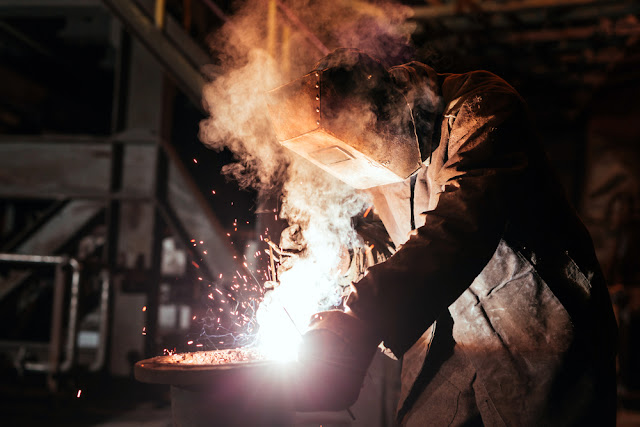12 Benefits of Welding
One of the most controversial debates in structural engineering is the bolted joint versus the welded joint. Welding is the practice of joining two pieces of material by heating the surfaces to their melting point and hammering and pressing them together so that the two pieces become one. Augello's Welding and Fabrication is your expert in welding and custom fabrication at the Lake of the Ozarks. Obviously, we are little biased toward the welded joint. Here's why.
1. Welding creates a permanent joint. Heating up the material to its melting point actually causes the atoms in the metal to join. This chemical joining causes the two separate pieces to permanently become one and the structure will, therefore, act as one piece.
2. Welded joints are stronger. Because welding chemically joins the atoms in the materials being joined, the welded joint has the strength of the parent metal itself. Other forms of joining can result in joints that are structurally weaker than a welded joint or than the parent material.
3. Welding can create a continuous joint with lower stress concentrations. One of the reasons welded joints are stronger is that welding creates a continuous joint. This results in lower stress concentrations than riveting, for example, which has stress concentrations around the rivets.
4. Welding creates a hermetic seal. This means that welding creates a joint that is airtight and watertight. Laser welding, one of the best ways to create a hermetic seal, is a crucial process in electronics industries, aerospace manufacturing, medical device manufacturers, and other industries where contaminants or leakage can be catastrophic.
5. Welding is quicker than other forms of joining. Because welding requires a simplified assembly and design process than riveting or other forms of joining, it is a faster process. If time is a concern for your project, welding is the way to go.
6. Welding structures are typically lighter in weight. Structures that are assembled by bolting or riveting require excess materials including gussets, filler plates, and other connecting components. These additional materials add to the overall weight of the structure.
7. Certain shapes are difficult to rivet. One of the reasons that riveting takes more time than welding is because of the extra planning and design that is required. Certain shapes, such as cylinders, are difficult to rivet and are much easier to weld.
8. Welding is more reliable. Especially for projects subject to dynamic loads or vibration, welding is much more reliable. Bolted joints can loosen over time, but once a joint is welded, the only way to take it apart is to destroy the whole structure.
9. Welding has a smoother appearance. The welding procedure results in a smooth joint that is more aesthetically and visually pleasing than riveting. Welding results in a more cohesive look to a project whereas riveting creates a structure with clearly separate parts.
10. Welds are required to go through more test certifications. The test certifications for welding are more traceable and accurate than the test certifications required for riveting. These tests give you the assurance that your welded joint is compliant, strong, and will stand the test of time. Some examples of welding test certifications are the hydro test and the gas test.
11. Welding does not require holes which means there is no reduction of area. Bolting and riveting require holes which can reduce the surface area of the structure. This can reduce the strength of the structure, and it requires more advanced planning. Additionally, welding makes it easier to add more components to the structure later on if you should decide to make updates down the road.
12. Welding requires less space than riveting. It is possible to weld almost any structure at any point, but riveting requires more clearance and workspace. Welding can be done virtually anywhere, from the bottom of the ocean to outerspace.
While riveting and welding both have benefits, we are big fans of the welded joint at Augello's Welding and Fabrication. In fact, we are the welding and fabrication experts at the Lake of the Ozarks. If it's made of metal, we can fix it or fabricate it, 100% satisfaction guaranteed. If you have a project that requires custom fabrication at the Lake of the Ozarks or a repair that requires welding at the Lake of the Ozarks, Augello's is your one-stop shop for all things metal. Call us today for a free estimate. We are here to answer all of your questions and help you in any way we can.
1. Welding creates a permanent joint. Heating up the material to its melting point actually causes the atoms in the metal to join. This chemical joining causes the two separate pieces to permanently become one and the structure will, therefore, act as one piece.
2. Welded joints are stronger. Because welding chemically joins the atoms in the materials being joined, the welded joint has the strength of the parent metal itself. Other forms of joining can result in joints that are structurally weaker than a welded joint or than the parent material.
3. Welding can create a continuous joint with lower stress concentrations. One of the reasons welded joints are stronger is that welding creates a continuous joint. This results in lower stress concentrations than riveting, for example, which has stress concentrations around the rivets.
4. Welding creates a hermetic seal. This means that welding creates a joint that is airtight and watertight. Laser welding, one of the best ways to create a hermetic seal, is a crucial process in electronics industries, aerospace manufacturing, medical device manufacturers, and other industries where contaminants or leakage can be catastrophic.
5. Welding is quicker than other forms of joining. Because welding requires a simplified assembly and design process than riveting or other forms of joining, it is a faster process. If time is a concern for your project, welding is the way to go.
6. Welding structures are typically lighter in weight. Structures that are assembled by bolting or riveting require excess materials including gussets, filler plates, and other connecting components. These additional materials add to the overall weight of the structure.
7. Certain shapes are difficult to rivet. One of the reasons that riveting takes more time than welding is because of the extra planning and design that is required. Certain shapes, such as cylinders, are difficult to rivet and are much easier to weld.
8. Welding is more reliable. Especially for projects subject to dynamic loads or vibration, welding is much more reliable. Bolted joints can loosen over time, but once a joint is welded, the only way to take it apart is to destroy the whole structure.
9. Welding has a smoother appearance. The welding procedure results in a smooth joint that is more aesthetically and visually pleasing than riveting. Welding results in a more cohesive look to a project whereas riveting creates a structure with clearly separate parts.
10. Welds are required to go through more test certifications. The test certifications for welding are more traceable and accurate than the test certifications required for riveting. These tests give you the assurance that your welded joint is compliant, strong, and will stand the test of time. Some examples of welding test certifications are the hydro test and the gas test.
11. Welding does not require holes which means there is no reduction of area. Bolting and riveting require holes which can reduce the surface area of the structure. This can reduce the strength of the structure, and it requires more advanced planning. Additionally, welding makes it easier to add more components to the structure later on if you should decide to make updates down the road.
12. Welding requires less space than riveting. It is possible to weld almost any structure at any point, but riveting requires more clearance and workspace. Welding can be done virtually anywhere, from the bottom of the ocean to outerspace.
While riveting and welding both have benefits, we are big fans of the welded joint at Augello's Welding and Fabrication. In fact, we are the welding and fabrication experts at the Lake of the Ozarks. If it's made of metal, we can fix it or fabricate it, 100% satisfaction guaranteed. If you have a project that requires custom fabrication at the Lake of the Ozarks or a repair that requires welding at the Lake of the Ozarks, Augello's is your one-stop shop for all things metal. Call us today for a free estimate. We are here to answer all of your questions and help you in any way we can.
Your Lake of the Ozark’s Welder & Place for All Things Custom!
Office Phone: (573) 207-0285
Cell Phone: (573) 286-9135
AugellosWelding@gmail.com
Follow Us On:









Comments
Post a Comment